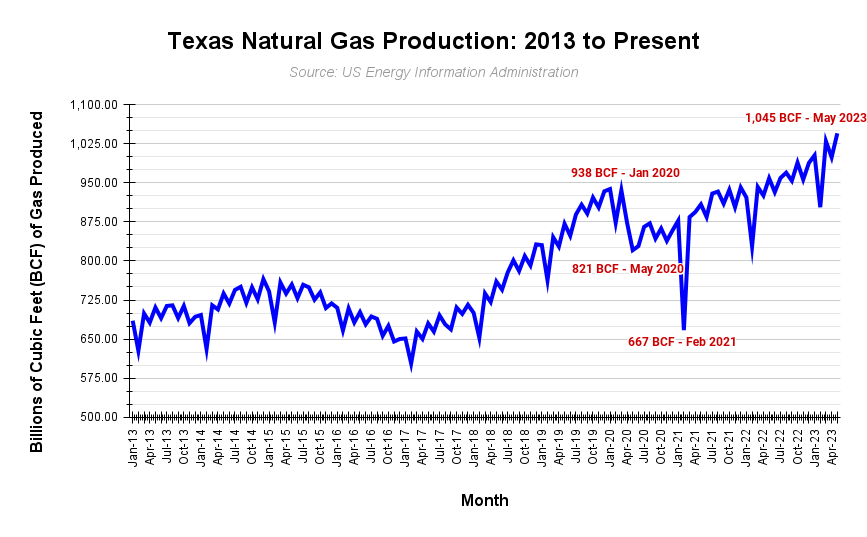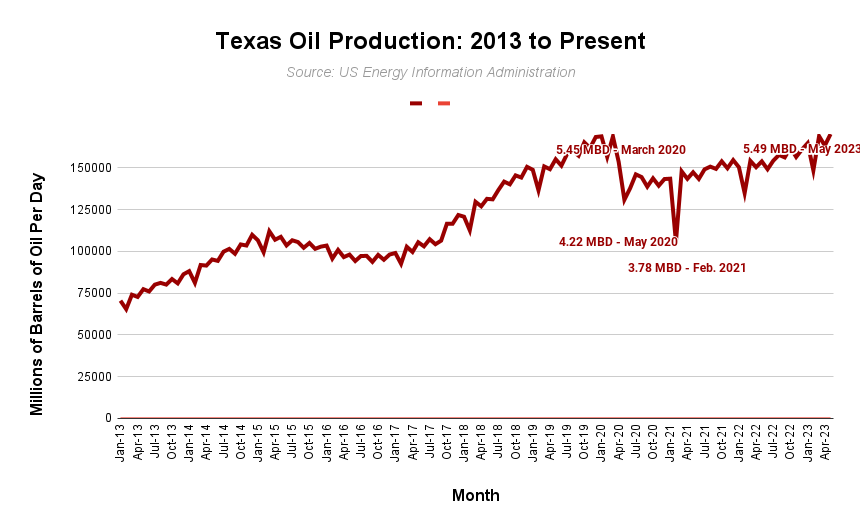Texas’ oil and gas production hits records
New data released by the U.S. Energy Information Administration this week reveals that Texas’ oil and gas production levels reached record highs in May. Fueled by high oil and gas prices throughout 2022, the new production levels beat those records set before the COVID-19 pandemic in the spring of 2020.
Here’s what you need to know:
Key Takeaway 1. Texas’ natural gas production surged into record-breaking territory this year.
In May 2023, Texas’ gas producers generated a new record of 1,045 billion cubic feet (BCF) — or 1.045 trillion cubic feet — of natural gas according to newly-released U.S. Energy Information Administration (USEIA) data.

This record-setting data indicates that Texas’ gas production has recovered from the setbacks observed during the COVID-19 pandemic in 2020 and Winter Storm Uri in 2021. On the eve of the COVID-19 pandemic of 2020, Texas’ natural gas production hit a new record high of 938 BCF. Four months later, in May of that same year, production declined to 821 BCF.
The tepid recovery for the remainder of 2020 and early 2021 was dealt another blow in February 2021 when Winter Storm Uri prompted a series of production stoppages, dropping the state’s production to 667 BCF.
Natural gas production has steadily increased since February 2021 to the new highs observed in May of this year. Some of this production growth is attributable to the growth in global demand for liquefied natural gas following Russia’s invasion of Ukraine.
Key Takeaway 2. Texas’ oil production just eclipsed the record set before the COVID-19 pandemic.
Just as Texas’ natural gas production has reached record levels in 2023, so, too, has oil production. Producers generated a record-breaking 5.49 million barrels per day (MDB) in May. The last time Texas’ oil producers set a production record was on the eve of the COVID-19 pandemic. As illustrated in the chart below, starting in mid-2017, statewide oil production underwent a dramatic rise leading to a high of 5.45 million MBD in March 2020.
The onset of the COVID-19 pandemic, and the corresponding demand destruction for oil, decimated production. By May 2020, oil production fell to 4.22 MBD from the high of 5.45 MBD observed just two months earlier. Winter Storm Uri delivered another blow, albeit brief, to Texas’ oil production in February 2021, lowering output to 3.78 MBD.

The good news from the USEIA data released earlier this week is that Texas’ oil production levels have fully recovered from the lows following the pandemic. Moreover, the new data indicates that Texas’ production in May of this year eclipsed the record last set in March 2020.
What does this mean for Texas?
Record oil and gas production levels could prove beneficial to both the state’s economy and the state government’s budget provided that the price of both commodities remains higher. Oil and gas sold for a premium for most of 2022: oil reached $114.82 in June as gas reached $8.81 in August. These high prices contributed to the historic budget surplus for the recent legislative session.
As of this summer, however, the price of oil and gas are significantly lower. Last week, the price of oil was $79.68 per barrel as the spot price for natural gas reached $2.59.
As discussed in an earlier report by Texas 2036, volatility in oil and gas prices and productivity carries significant implications for the state’s fiscal health, including public education funding.
Given the importance of energy revenues to our state’s budget and economy, Texas 2036 is developing new models describing how changes in our energy portfolio will affect future growth. These exciting new models will be released later this year. Stay tuned.
Read more:
- How The (Proposed) New Texas Water Fund Works
- The path forward for Texas’ hydrogen policy
- Texas poised to help hydrogen fuel industry soar
Love this blog? Support our work.
